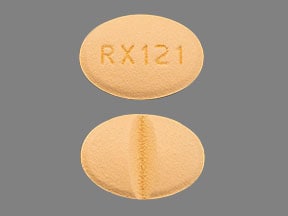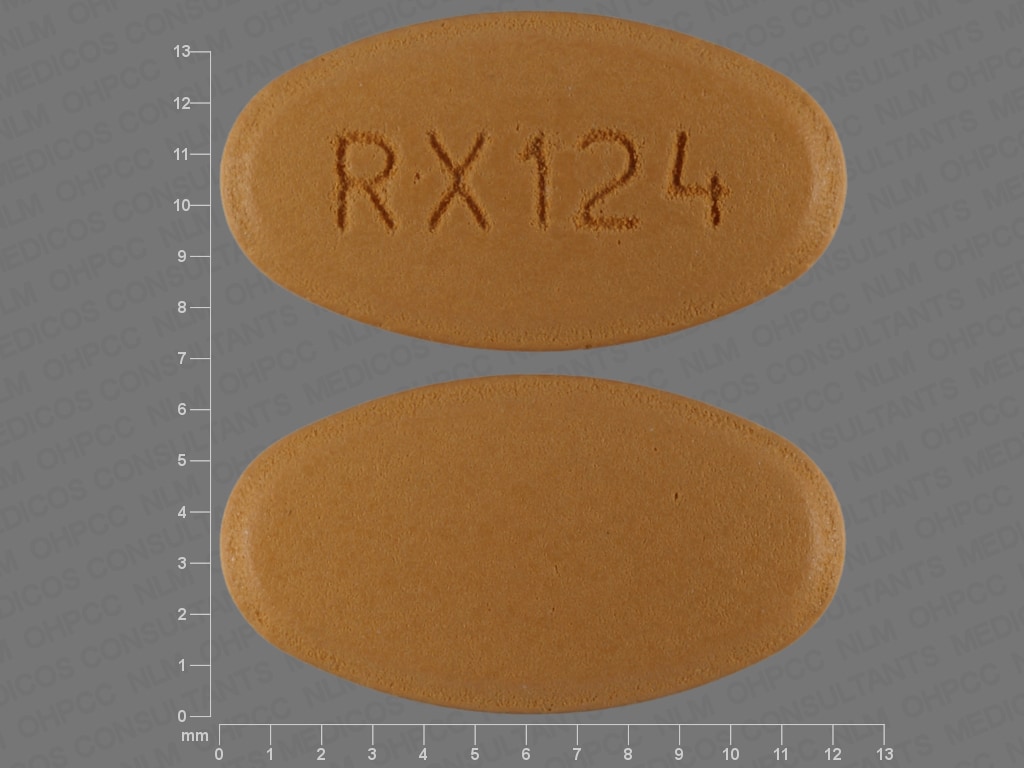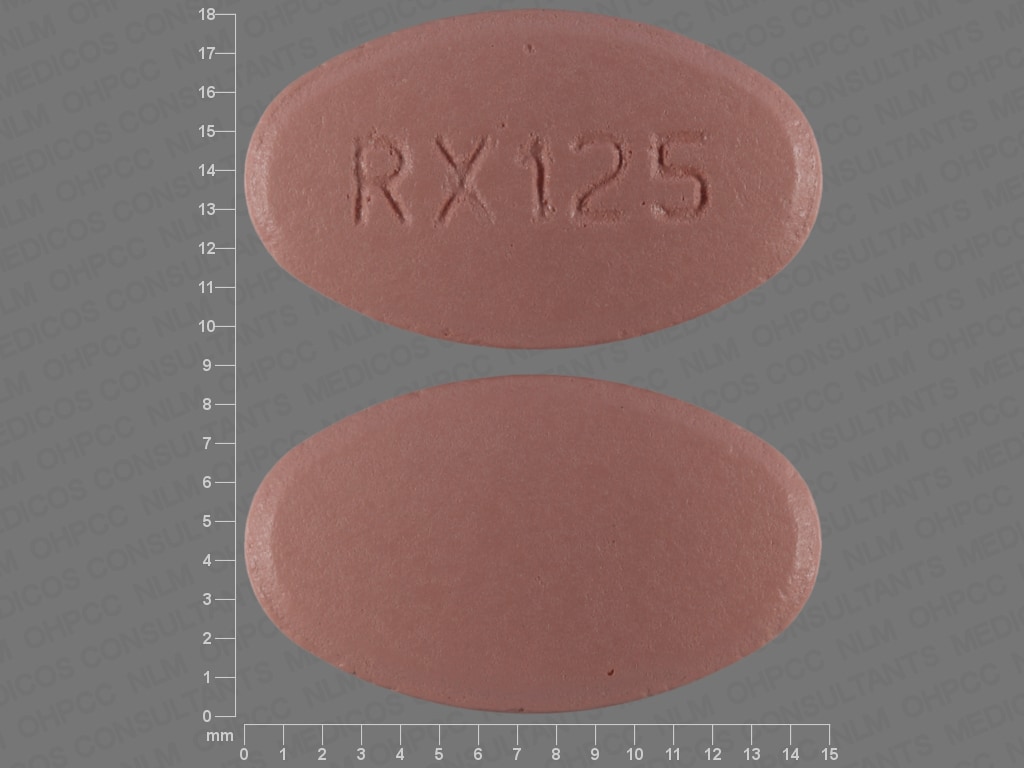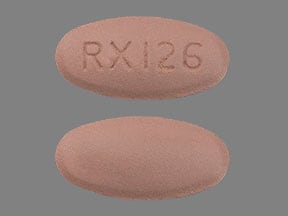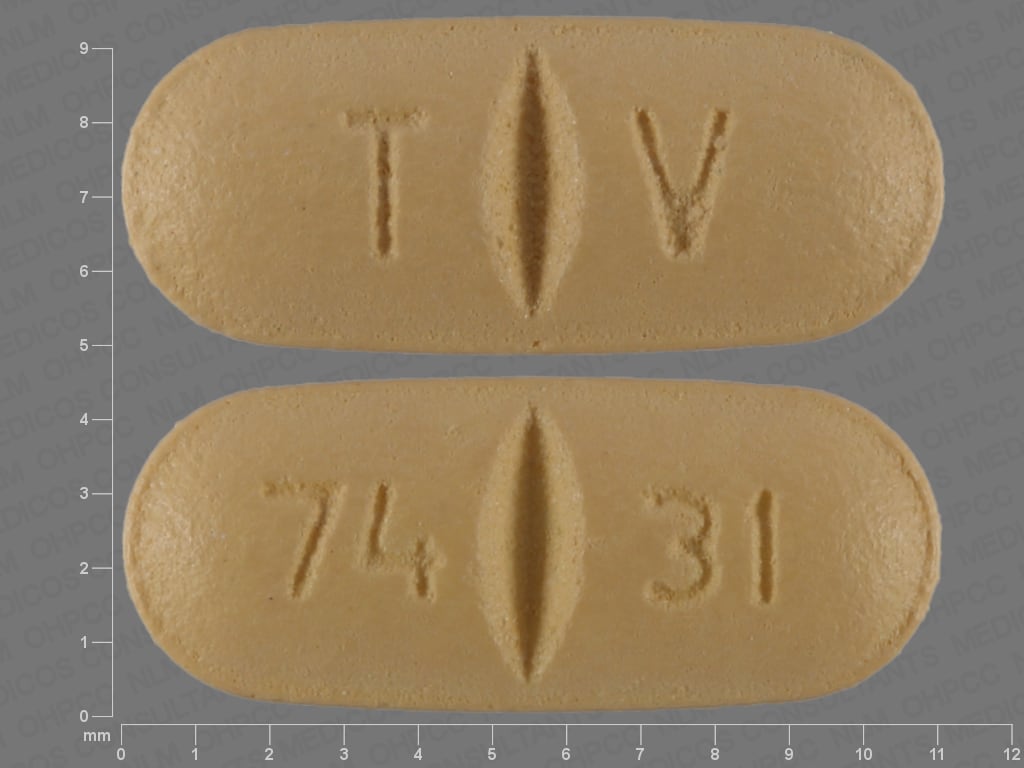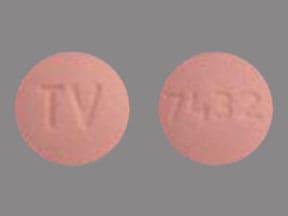Boxed Warning
Fetal toxicity:
Drugs that act directly on the renin-angiotensin system can cause injury and death to the developing fetus. When pregnancy is detected, discontinue valsartan as soon as possible.
Dosage Forms
Excipient information presented when available (limited, particularly for generics); consult specific product labeling.
Tablet, Oral:
Diovan: 40 mg [scored]
Diovan: 80 mg, 160 mg, 320 mg
Generic: 40 mg, 80 mg, 160 mg, 320 mg
Pharmacology
Mechanism of Action
Valsartan produces direct antagonism of the angiotensin II (AT2) receptors, unlike the ACE inhibitors. It displaces angiotensin II from the AT1 receptor and produces its blood pressure-lowering effects by antagonizing AT1-induced vasoconstriction, aldosterone release, catecholamine release, arginine vasopressin release, water intake, and hypertrophic responses. This action results in more efficient blockade of the cardiovascular effects of angiotensin II and fewer side effects than the ACE inhibitors.
Pharmacokinetics/Pharmacodynamics
Distribution
Vd: 17 L
Metabolism
To inactive metabolite (valeryl 4-hydroxy valsartan)
Excretion
Feces (83%) and urine (~13%) as unchanged drug
Clearance: Found to be similar per kg bodyweight in children vs adults receiving a single dose of the suspension (Blumer 2009)
Onset of Action
~2 hours
Time to Peak
Serum:
Children and Adolescents 1 to 16 years: Oral suspension: 2 hours (Blumer 2009)
Adults: Tablets: 2 to 4 hours; Oral solution: 0.7 to 3.7 hours (high-fat, high-calorie meal decreased Cmax ~44%)
Duration of Action
24 hours
Half-Life Elimination
Children 1 to 5 years: ~4 hours (Blumer 2009)
Children and Adolescents 6 to 16 years: ~5 hours (Blumer 2009)
Adults: ~6 hours; ~35% longer in elderly patients
Protein Binding
95%, primarily albumin
Use in Specific Populations
Special Populations: Hepatic Function Impairment
Patients with mild-to-moderate chronic liver disease have about twice the AUC value.
Special Populations: Elderly
AUC is about 70% higher and the half-life is 35% longer in elderly patients.
Use: Labeled Indications
Heart failure: Treatment of heart failure (NYHA Class II to IV)
Guideline recommendations: The American College of Cardiology/American Heart Association (ACC/AHA) 2013 heart failure guidelines recommend the use of ARBs (ie, candesartan, losartan, and valsartan) in patients with HF with reduced ejection fraction who cannot tolerate ACE inhibitors to reduce morbidity and mortality. They also suggest that ARBs are reasonable first-line alternatives to ACE inhibitors in patients already maintained on an ARB for other indications (ACC/AHA [Yancy 2013]).
Hypertension: Management of hypertension
Guideline recommendations: The 2017 Guideline for the Prevention, Detection, Evaluation, and Management of High Blood Pressure in Adults recommends if monotherapy is warranted, in the absence of comorbidities (eg, cerebrovascular disease, chronic kidney disease, diabetes, heart failure, ischemic heart disease, etc.), that thiazide-like diuretics or dihydropyridine calcium channel blockers may be preferred options due to improved cardiovascular endpoints (eg, prevention of heart failure and stroke). ACE inhibitors and ARBs are also acceptable for monotherapy. Combination therapy may be required to achieve blood pressure goals and is initially preferred in patients at high risk (stage 2 hypertension or atherosclerotic cardiovascular disease [ASCVD] risk ≥10%) (ACC/AHA [Whelton 2017]).
Left ventricular dysfunction or failure after MI: Reduction of cardiovascular mortality in patients with left ventricular dysfunction or failure postmyocardial infarction
Use: Off Label
Acute coronary syndrome (secondary prevention of cardiovascular events)yes
Based on the American Heart Association/American College of Cardiology (AHA/ACC) guidelines for the management of patients with non-ST-elevation acute coronary syndromes (NSTE-ACS) and the American College of Cardiology/American Heart Association (ACC/AHA) guidelines for the management of patients with STE-ACS, an ARB is recommended and effective in patients with NSTE-ACS or STE-ACS who have indications for but are intolerant of ACE inhibitors; this includes patients with heart failure, MI, or anterior MI who have a left ventricular ejection fraction (LVEF) ≤40%. In post-STE-ACS patients, initiate within the first 24 hours.
Stable coronary artery diseaseyes
Based on the American College of Cardiology/American Heart Association guideline for the diagnosis and management of patients with stable ischemic heart disease, an ACE inhibitor or ARB should be prescribed in all patients with stable ischemic heart disease who also have hypertension, diabetes mellitus, LVEF <40%, or CKD unless contraindicated.
Contraindications
Hypersensitivity to valsartan or any component of the formulation; concomitant use with aliskiren in patients with diabetes mellitus
Documentation of allergenic cross-reactivity for angiotensin II receptor blockers is limited. However, because of similarities in chemical structure and/or pharmacologic actions, the possibility of cross-sensitivity cannot be ruled out with certainty.
Canadian labeling: Additional contraindications (not in US labeling): Concomitant use with aliskiren in patients with moderate to severe renal impairment (GFR <60 mL/minute/1.73 m2); pregnancy; breastfeeding
Dosage and Administration
Dosing: Adult
Note: Commercially available oral solution is not therapeutically equivalent to the tablet formulation.
Hypertension: Oral: Initial:
Oral solution: 40 to 80 mg twice daily; titrate as needed based on patient response up to 320 mg/day in 2 divided doses; maximum dose: 320 mg/day
Tablet: 80 mg or 160 mg once daily; titrate as needed based on patient response up to 320 mg/day (ACC/AHA [Whelton 2017]); maximum dose: 320 mg/day
Heart failure: Oral: Initial: 20 to 40 mg twice daily; titrate dose to 80 mg twice daily, and then to 160 mg twice daily (target dose), as tolerated; maximum dose: 320 mg/day (ACC/AHA [Yancy 2013])
Left ventricular dysfunction or failure after MI: Oral: Initial: 20 mg twice daily; may increase within 7 days to 40 mg twice daily; titrate dose to target of 160 mg twice daily as tolerated; may initiate ≥12 hours following MI
Dosing: Geriatric
Refer to adult dosing.
Dosing: Pediatric
Hypertension: Note: Oral dosage forms (tablets, solution [commercially available], and compounded suspension) are not bioequivalent on a mg:mg basis. Due to increased bioavailability of commercially available oral solution and extemporaneously prepared oral suspension, patients may require a higher dose when converting from oral suspension/solution to tablet dosage form. Consider lower listed initial dose in patients with hyponatremia, hypovolemia, severe CHF, decreased renal function, or in those receiving diuretics.
Infants 6 months to Children <6 years, weighing ≥6 kg and ≤40 kg: Limited data available; optimal dosage not defined: Oral: Extemporaneously compounded oral suspension was used in the trials (Flynn 2008; Schaefer 2013): Reported dosage range: 0.25 to 4 mg/kg/dose once daily. Dosing based on two multicenter, international, placebo-controlled, dose-response trials and open-label extensions (Flynn 2008; Schaefer 2013). In one trial, patients 6 months to <6 years weighing ≥6 kg and ≤40 kg, weight-directed initial doses of 0.25 mg/kg, 1 mg/kg, and 4 mg/kg once daily were used during the initial 6-week, placebo-controlled phase; significant reduction in SBP/DBP were observed; a dose-response trend was observed (greater BP reductions with medium and high doses) but statistical significance was not achieved and all doses were associated with statistically significant decreases in BP. In the open-label extension, doses were initiated at 1 mg/kg once daily and titrated at 2 weeks by doubling the dose to 2 mg/kg once daily and again at 4 weeks to 4 mg/kg once daily; maximum daily dose: 4 mg/kg/day or 160 mg/day, whichever is less; results from the extension were comparable to the initial dose-finding results (Schaefer 2013). Another trial of 90 children 1 to 5 years (mean age: 3.2 years; minimum patient weight: 8 kg) randomized patients to receive low, medium, or high doses according to patient body weight. Patients <18 kg received low dose: 5 mg once daily; medium dose: 20 mg once daily; or high dose: 40 mg once daily. Patients ≥18 kg received low dose: 10 mg once daily; medium dose: 40 mg once daily; or high dose: 80 mg once daily, resulting in a mean exposure dose of 0.4 to 3.4 mg/kg/day. Results showed significant antihypertensive effects in all dose level groups (Flynn 2008).
Children and Adolescents 6 to 16 years: Note: Obese pediatric patients 6 to 16 years were observed to respond at similar doses as nonobese (Meyers 2011):
Oral solution (commercially available): Initial: 0.65 mg/kg/dose twice daily; maximum initial daily dose: 40 mg/day; may titrate to effect up to a maximum dose: 1.35 mg/kg/dose twice daily; maximum daily dose: 160 mg/day
Tablets: Initial: 1.3 mg/kg once daily; maximum initial daily dose: 40 mg/day; may titrate to effect up to a maximum dose of 2.7 mg/kg/dose once daily or maximum daily dose: 160 mg/day (AAP [Flynn 2017]), whichever is lower; doses greater than this have not been studied
Adolescents ≥17 years:
Oral solution (commercially available): Initial: 40 or 80 mg twice daily; may titrate to effect up to a maximum daily dose: 320 mg/day
Tablets: Initial: 80 mg or 160 mg once daily; may titrate to effect up to a maximum daily dose: 320 mg/day
Extemporaneously Prepared
A 4 mg/mL oral suspension may be made from tablets, Ora-Plus, and Ora-Sweet SF. Add 80 mL of Ora-Plus to an 8-ounce amber glass bottle containing eight valsartan 80 mg tablets. Shake well for ≥2 minutes. Allow the suspension to stand for a minimum of 1 hour, then shake for ≥1 minute. Add 80 mL of Ora-Sweet SF to the bottle and shake for ≥10 seconds. Store in amber glass prescription bottles; label "shake well". Stable for 30 days at room temperature, below 30°C (86°F), or 75 days refrigerated.
Diovan prescribing information, Novartis Pharmaceuticals Corp, East Hanover, NJ, 2017.
Administration
Oral: Administer with or without food.
Dietary Considerations
Avoid salt substitutes which contain potassium.
Storage
Store tablets at 25°C (77°F) and solution at 20°C to 25°C (68°F to 77°F); excursions permitted to 15°C to 30°C (59°F to 86°F). Protect from moisture.
Valsartan Images
Drug Interactions
Alfuzosin: May enhance the hypotensive effect of Blood Pressure Lowering Agents. Monitor therapy
Aliskiren: May enhance the hyperkalemic effect of Angiotensin II Receptor Blockers. Aliskiren may enhance the hypotensive effect of Angiotensin II Receptor Blockers. Aliskiren may enhance the nephrotoxic effect of Angiotensin II Receptor Blockers. Management: Aliskiren use with ACEIs or ARBs in patients with diabetes is contraindicated. Combined use in other patients should be avoided, particularly when CrCl is less than 60 mL/min. If combined, monitor potassium, creatinine, and blood pressure closely. Consider therapy modification
Amifostine: Blood Pressure Lowering Agents may enhance the hypotensive effect of Amifostine. Management: When amifostine is used at chemotherapy doses, blood pressure lowering medications should be withheld for 24 hours prior to amifostine administration. If blood pressure lowering therapy cannot be withheld, amifostine should not be administered. Consider therapy modification
Amphetamines: May diminish the antihypertensive effect of Antihypertensive Agents. Monitor therapy
Angiotensin II: Receptor Blockers may diminish the therapeutic effect of Angiotensin II. Monitor therapy
Angiotensin-Converting Enzyme Inhibitors: Angiotensin II Receptor Blockers may enhance the adverse/toxic effect of Angiotensin-Converting Enzyme Inhibitors. Angiotensin II Receptor Blockers may increase the serum concentration of Angiotensin-Converting Enzyme Inhibitors. Management: In US labeling, use of telmisartan and ramipril is not recommended. It is not clear if any other combination of an ACE inhibitor and an ARB would be any safer. Consider alternatives to the combination when possible. Consider therapy modification
Antihepaciviral Combination Products: May increase the serum concentration of Valsartan. Management: Per antihepaciviral combination product US prescribing information, consider decreasing the valsartan dose and monitoring for evidence of hypotension and worsening renal function if these agents are used in combination. Consider therapy modification
Antipsychotic Agents (Second Generation [Atypical]): Blood Pressure Lowering Agents may enhance the hypotensive effect of Antipsychotic Agents (Second Generation [Atypical]). Monitor therapy
Barbiturates: May enhance the hypotensive effect of Blood Pressure Lowering Agents. Monitor therapy
Benperidol: May enhance the hypotensive effect of Blood Pressure Lowering Agents. Monitor therapy
Brigatinib: May diminish the antihypertensive effect of Antihypertensive Agents. Brigatinib may enhance the bradycardic effect of Antihypertensive Agents. Monitor therapy
Brimonidine (Topical): May enhance the hypotensive effect of Blood Pressure Lowering Agents. Monitor therapy
Bromperidol: Blood Pressure Lowering Agents may enhance the hypotensive effect of Bromperidol. Bromperidol may diminish the hypotensive effect of Blood Pressure Lowering Agents. Avoid combination
CycloSPORINE (Systemic): Angiotensin II Receptor Blockers may enhance the hyperkalemic effect of CycloSPORINE (Systemic). Monitor therapy
Dapoxetine: May enhance the orthostatic hypotensive effect of Angiotensin II Receptor Blockers. Monitor therapy
Dexmethylphenidate: May diminish the therapeutic effect of Antihypertensive Agents. Monitor therapy
Diazoxide: May enhance the hypotensive effect of Blood Pressure Lowering Agents. Monitor therapy
Drospirenone: Angiotensin II Receptor Blockers may enhance the hyperkalemic effect of Drospirenone. Monitor therapy
DULoxetine: Blood Pressure Lowering Agents may enhance the hypotensive effect of DULoxetine. Monitor therapy
Eltrombopag: May increase the serum concentration of OATP1B1/1B3 (SLCO1B1/1B3) Substrates. Monitor therapy
Eplerenone: May enhance the hyperkalemic effect of Angiotensin II Receptor Blockers. Monitor therapy
Gemfibrozil: May increase the serum concentration of OATP1B1/1B3 (SLCO1B1/1B3) Substrates. See separate drug interaction monographs for agents listed as exceptions. Monitor therapy
Heparin: May enhance the hyperkalemic effect of Angiotensin II Receptor Blockers. Monitor therapy
Heparins (Low Molecular Weight): May enhance the hyperkalemic effect of Angiotensin II Receptor Blockers. Monitor therapy
Herbs (Hypertensive Properties): May diminish the antihypertensive effect of Antihypertensive Agents. Monitor therapy
Herbs (Hypotensive Properties): May enhance the hypotensive effect of Blood Pressure Lowering Agents. Monitor therapy
HydroCHLOROthiazide: May enhance the hypotensive effect of Valsartan. Valsartan may increase the serum concentration of HydroCHLOROthiazide. Monitor therapy
Hypotension-Associated Agents: Blood Pressure Lowering Agents may enhance the hypotensive effect of Hypotension-Associated Agents. Monitor therapy
Levodopa-Containing Products: Blood Pressure Lowering Agents may enhance the hypotensive effect of Levodopa-Containing Products. Monitor therapy
Lithium: Angiotensin II Receptor Blockers may increase the serum concentration of Lithium. Management: Lithium dosage reductions will likely be needed following the addition of an angiotensin II receptor antagonist. Consider therapy modification
Lormetazepam: May enhance the hypotensive effect of Blood Pressure Lowering Agents. Monitor therapy
Methylphenidate: May diminish the antihypertensive effect of Antihypertensive Agents. Monitor therapy
Molsidomine: May enhance the hypotensive effect of Blood Pressure Lowering Agents. Monitor therapy
Naftopidil: May enhance the hypotensive effect of Blood Pressure Lowering Agents. Monitor therapy
Nicergoline: May enhance the hypotensive effect of Blood Pressure Lowering Agents. Monitor therapy
Nicorandil: May enhance the hyperkalemic effect of Angiotensin II Receptor Blockers. Monitor therapy
Nicorandil: May enhance the hypotensive effect of Blood Pressure Lowering Agents. Monitor therapy
Nitroprusside: Blood Pressure Lowering Agents may enhance the hypotensive effect of Nitroprusside. Monitor therapy
Nonsteroidal Anti-Inflammatory Agents: Angiotensin II Receptor Blockers may enhance the adverse/toxic effect of Nonsteroidal Anti-Inflammatory Agents. Specifically, the combination may result in a significant decrease in renal function. Nonsteroidal Anti-Inflammatory Agents may diminish the therapeutic effect of Angiotensin II Receptor Blockers. The combination of these two agents may also significantly decrease glomerular filtration and renal function. Monitor therapy
Obinutuzumab: May enhance the hypotensive effect of Blood Pressure Lowering Agents. Management: Consider temporarily withholding blood pressure lowering medications beginning 12 hours prior to obinutuzumab infusion and continuing until 1 hour after the end of the infusion. Consider therapy modification
Pentoxifylline: May enhance the hypotensive effect of Blood Pressure Lowering Agents. Monitor therapy
Pholcodine: Blood Pressure Lowering Agents may enhance the hypotensive effect of Pholcodine. Monitor therapy
Phosphodiesterase 5 Inhibitors: May enhance the hypotensive effect of Blood Pressure Lowering Agents. Monitor therapy
Potassium Salts: May enhance the hyperkalemic effect of Angiotensin II Receptor Blockers. Monitor therapy
Potassium-Sparing Diuretics: Angiotensin II Receptor Blockers may enhance the hyperkalemic effect of Potassium-Sparing Diuretics. Monitor therapy
Prostacyclin Analogues: May enhance the hypotensive effect of Blood Pressure Lowering Agents. Monitor therapy
Quinagolide: May enhance the hypotensive effect of Blood Pressure Lowering Agents. Monitor therapy
Ranolazine: May enhance the adverse/toxic effect of Angiotensin II Receptor Blockers. Monitor therapy
Sodium Phosphates: Angiotensin II Receptor Blockers may enhance the nephrotoxic effect of Sodium Phosphates. Specifically, the risk of acute phosphate nephropathy may be enhanced. Management: Consider avoiding this combination by temporarily suspending treatment with ARBs, or seeking alternatives to oral sodium phosphate bowel preparation. If the combination cannot be avoided, maintain adequate hydration and monitor renal function closely. Consider therapy modification
Tacrolimus (Systemic): Angiotensin II Receptor Blockers may enhance the hyperkalemic effect of Tacrolimus (Systemic). Monitor therapy
Teriflunomide: May increase the serum concentration of OATP1B1/1B3 (SLCO1B1/1B3) Substrates. Monitor therapy
Tolvaptan: May increase the serum concentration of OATP1B1/1B3 (SLCO1B1/1B3) Substrates. Consider therapy modification
Trimethoprim: May enhance the hyperkalemic effect of Angiotensin II Receptor Blockers. Monitor therapy
Yohimbine: May diminish the antihypertensive effect of Antihypertensive Agents. Monitor therapy
Test Interactions
May lead to false-negative aldosterone/renin ratio (ARR) (Funder 2016)
Adverse Reactions
Adverse reactions occurred with heart failure or post-MI unless otherwise indicated.
>10%:
Central nervous system: Dizziness (17%; hypertension: 2% to 8%)
Renal: Increased blood urea nitrogen (>50% increase: 17%)
1% to 10%:
Cardiovascular: Hypotension (6% to 7%; hypertension: <1%), orthostatic hypotension (2%), syncope (>1%; hypertension: <1%)
Central nervous system: Fatigue (2% to 3%), orthostatic dizziness (≤2%), headache (>1%), vertigo (>1%)
Endocrine & metabolic: Hyperkalemia (2%)
Gastrointestinal: Diarrhea (5%), abdominal pain (hypertension: 2%), nausea (>1%), upper abdominal pain (>1%)
Hematologic & oncologic: Neutropenia (2%)
Infection: Viral infection (hypertension: 3%)
Neuromuscular & skeletal: Arthralgia (3%), back pain (3%; hypertension: <1%)
Ophthalmic: Blurred vision (>1%)
Renal: Increased serum creatinine (≤4%), renal insufficiency (>1%)
Respiratory: Dry cough (hypertension: 3%)
<1%, postmarketing, and/or case reports: Alopecia, angioedema, anorexia, anxiety, asthenia, bullous dermatitis, chest pain, constipation, drowsiness, dyspepsia, dyspnea, flatulence, hepatitis, hypersensitivity reaction, impotence, increased liver enzymes, insomnia, muscle cramps, myalgia, palpitation, paresthesia, pruritus, renal failure syndrome, rhabdomyolysis, skin rash, thrombocytopenia, vasculitis, vomiting, xerostomia
Warnings/Precautions
Concerns related to adverse effects:
- Angioedema: Angioedema has been reported rarely with some angiotensin II receptor antagonists (ARBs) and may occur at any time during treatment (especially following first dose). It may involve the head and neck (potentially compromising airway) or the intestine (presenting with abdominal pain). Patients with idiopathic or hereditary angioedema or previous angioedema associated with ACE-inhibitor therapy may be at an increased risk. Prolonged frequent monitoring may be required, especially if tongue, glottis, or larynx are involved, as they are associated with airway obstruction. Patients with a history of airway surgery may have a higher risk of airway obstruction. Discontinue therapy immediately if angioedema occurs. Aggressive early management is critical. Intramuscular (IM) administration of epinephrine may be necessary. Do not readminister to patients who have had angioedema with ARBs.
- Hyperkalemia: May occur; risk factors include renal dysfunction, diabetes mellitus, concomitant use of potassium-sparing diuretics, potassium supplements, and/or potassium-containing salts. Use with caution with these agents; monitor potassium closely.
- Hypotension: Symptomatic hypotension may occur upon initiation in patients who are salt- or volume-depleted (eg, those treated with high-dose diuretics); correct volume depletion prior to administration. This transient hypotensive response is not a contraindication to further treatment with valsartan.
- Renal function deterioration: May be associated with deterioration of renal function and/or increases in serum creatinine, particularly in patients with low renal blood flow (eg, renal artery stenosis, heart failure) whose glomerular filtration rate (GFR) is dependent on efferent arteriolar vasoconstriction by angiotensin II; deterioration may result in oliguria, acute renal failure, and progressive azotemia. Small increases in serum creatinine may occur following initiation; consider discontinuation only in patients with progressive and/or significant deterioration in renal function.
Disease-related concerns:
- Aortic/mitral stenosis: Use with caution in patients with significant aortic/mitral stenosis.
- Ascites: Avoid use in patients with ascites due to cirrhosis or refractory ascites; if use cannot be avoided in patients with ascites due to cirrhosis, monitor blood pressure and renal function carefully to avoid rapid development of renal failure (AASLD [Runyon 2012]).
- Heart failure: Use caution when initiating in heart failure; may need to adjust dose, and/or concurrent diuretic therapy, because of valsartan-induced hypotension. Careful monitoring of blood urea nitrogen (BUN), serum creatinine, and potassium is necessary especially if pre-existing renal disease exists.
- Hepatic impairment: Use with caution in patients with hepatic impairment (exposure to valsartan is increased).
- Renal artery stenosis: Use with caution in patients with unstented unilateral/bilateral renal artery stenosis. When unstented bilateral renal artery stenosis is present, use is generally avoided due to the elevated risk of deterioration in renal function unless possible benefits outweigh risks.
- Renal impairment: Use with caution in patients with renal impairment.
Concurrent drug therapy issues:
- Drug-drug interactions: Potentially significant interactions may exist, requiring dose or frequency adjustment, additional monitoring, and/or selection of alternative therapy. Consult drug interactions database for more detailed information.
Dosage form specific issues:
- Propylene glycol: Some dosage forms may contain propylene glycol; large amounts are potentially toxic and have been associated hyperosmolality, lactic acidosis, seizures and respiratory depression; use caution (AAP 1997; Zar 2007). See manufacturer’s labeling.
- Solution: Commercially available oral solution is not therapeutically equivalent to the tablet formulation.
Special populations:
- Pregnancy: [US Boxed Warning]: Drugs that act on the renin-angiotensin system can cause injury and death to the developing fetus. Discontinue as soon as possible once pregnancy is detected.
- Surgical patients: In patients on chronic angiotensin receptor blocker (ARB) therapy, intraoperative hypotension may occur with induction and maintenance of general anesthesia; however, discontinuation of therapy prior to surgery is controversial. If continued preoperatively, avoidance of hypotensive agents during surgery is prudent (Hillis 2011). Based on current research and clinical guidelines in patients undergoing non-cardiac surgery, continuing ARBs is reasonable in the perioperative period. If ARBs are held before surgery, it is reasonable to restart postoperatively as soon as clinically feasible (ACC/AHA [Fleisher 2014]).
Monitoring Parameters
Baseline and periodic blood pressure, electrolyte panels, renal function
Heart Failure: Within 1 to 2 weeks after initiation, reassess blood pressure (including postural blood pressure changes), renal function, and serum potassium; follow closely after dose changes. Patients with systolic blood pressure <80 mm Hg, low serum sodium, diabetes mellitus, and impaired renal function should be closely monitored (ACC/AHA [Yancy 2013])
Hypertension: The 2017 Guideline for the Prevention, Detection, Evaluation, and Management of High Blood Pressure in Adults (ACC/AHA [Whelton 2017]):
Confirmed hypertension and known CVD or 10-year atherosclerotic cardiovascular disease (ASCVD) risk ≥10%: Target blood pressure <130/80 mm Hg is recommended.
Confirmed hypertension without markers of increased ASCVD risk: Target blood pressure <130/80 mm Hg may be reasonable.
Diabetes and hypertension: The American Diabetes Association (ADA) guidelines (ADA 2019):
Patients 18 to 65 years of age, without ASCVD, and 10-year ASCVD risk <15%: Target blood pressure <140/90 mm Hg is recommended.
Patients 18 to 65 years of age and known ASCVD or 10-year ASCVD risk >15%: Target blood pressure <130/80 mm Hg may be appropriate if it can be safely attained.
Patients >65 years of age (healthy or complex/intermediate health): Target blood pressure <140/90 mm Hg is recommended.
Patients >65 years of age (very complex/poor health): Target blood pressure <150/90 mm Hg is recommended.
Pregnancy
Pregnancy Considerations
[US Boxed Warning]: Drugs that act on the renin-angiotensin system can cause injury and death to the developing fetus. When pregnancy is detected, discontinue as soon as possible. The use of drugs that act on the renin-angiotensin system are associated with oligohydramnios. Oligohydramnios, due to decreased fetal renal function, may lead to fetal lung hypoplasia and skeletal malformations. Oligohydramnios may not appear until after irreversible fetal injury has occurred. Use in pregnancy is also associated with anuria, hypotension, renal failure, skull hypoplasia, and death in the fetus/neonate. The exposed fetus should be monitored for fetal growth, amniotic fluid volume, and organ formation. Infants exposed in utero should be monitored for hyperkalemia, hypotension, and oliguria (exchange transfusions or dialysis may be needed). These adverse events are generally associated with maternal use in the second and third trimesters.
Chronic maternal hypertension may increase the risk of birth defects, low birth weight, preterm delivery, stillbirth, and neonatal death. Actual fetal/neonatal risks may be related to duration and severity of maternal hypertension. Untreated hypertension may also increase the risk of adverse maternal outcomes, including gestational diabetes, myocardial infarction, preeclampsia, stroke, and delivery complications (ACOG 203 2019).
The use of angiotensin II receptor blockers is generally not recommended to treat chronic hypertension in pregnant women and should generally be avoided in women planning a pregnancy (ACOG 203 2019).
Patient Education
What is this drug used for?
- It is used to treat high blood pressure, heart failure (weak heart), and to help heart function after a heart attack. It may be given to you for other reasons. Talk with the doctor.
Frequently reported side effects of this drug
- Abdominal pain
- Back pain
- Diarrhea
- Loss of strength and energy
- Joint pain
- Headache
- Flu-like symptoms
Other side effects of this drug: Talk with your doctor right away if you have any of these signs of:
- Kidney problems like unable to pass urine, blood in the urine, change in amount of urine passed, or weight gain
- High potassium like abnormal heartbeat, confusion, dizziness, passing out, weakness, shortness of breath, or numbness or tingling feeling
- Severe dizziness
- Passing out
- Swelling of arms or legs
- Vision changes
- Educate patient about signs of a significant reaction (eg, wheezing; chest tightness; fever; itching; bad cough; blue skin color; seizures; or swelling of face, lips, tongue, or throat). Note: This is not a comprehensive list of all side effects. Patient should consult prescriber for additional questions.
Intended Use and Disclaimer: Should not be printed and given to patients. This information is intended to serve as a concise initial reference for health care professionals to use when discussing medications with a patient. You must ultimately rely on your own discretion, experience, and judgment in diagnosing, treating, and advising patients.
